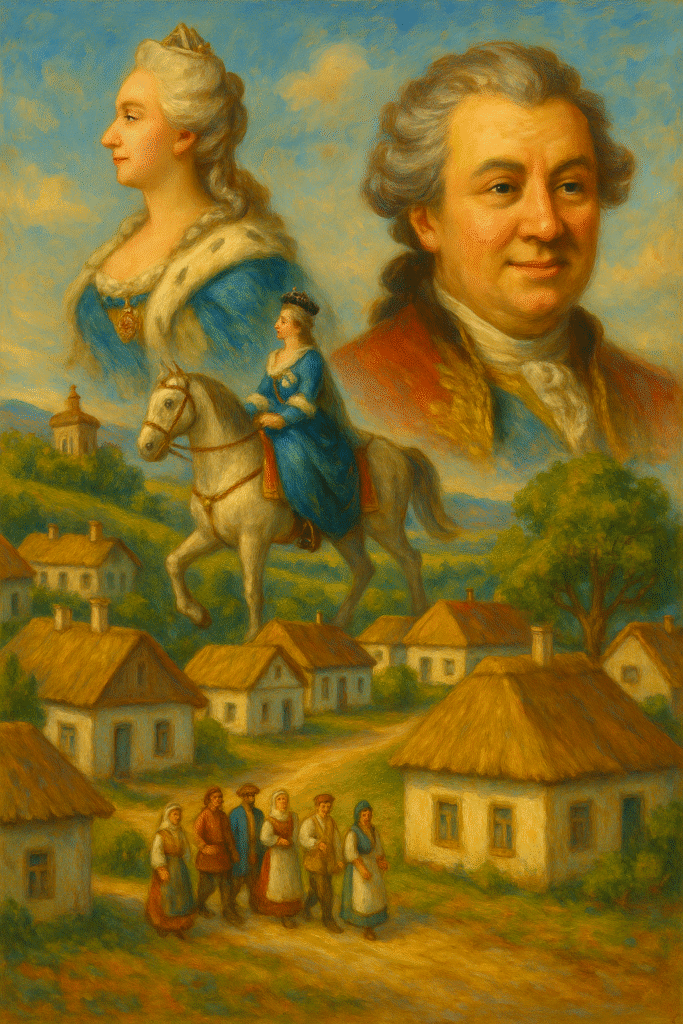Catherine the Great, or Catherine II, reigns as one of Russia’s most iconic monarchs. Her rule, spanning 1762 to 1796, dramatically transformed Russia’s political landscape, economy, and culture. A renowned reformer, she spearheaded modernization and significant territorial expansion. Central to her reign was Grigory Potemkin, her close advisor and confidant. Potemkin, a prominent military leader and politician, wielded considerable influence, impacting territorial governance and military strategy.
The Myth of the Potemkin Villages
The term “Potemkin Villages” has become synonymous with political deception, representing a façade crafted to project a false image of success. This phrase is often linked to Catherine the Great’s reign and her efforts to showcase a prosperous empire to European diplomats. But how much of this narrative is rooted in historical fact? This exploration delves into the historical context of Potemkin Villages, examining the evidence (Potemkin village) and their lasting cultural impact. (source: Britannica)
Catherine the Great and Potemkin: A Historical Context
Understanding the Potemkin Villages necessitates examining the political and social climate of 18th-century Russia. Following a coup against her husband, Peter III, Catherine emerged as an enlightened despot, embracing Western ideals while consolidating power. Grigory Potemkin’s influence as a military leader, confidant, and even lover, was paramount. He orchestrated numerous military campaigns, expanding Russia’s territory, and shared Catherine’s vision of a modernized Russia. Amidst peasant uprisings and foreign wars, Potemkin sought to project an image of strength and achievement, allegedly constructing mock villages along Catherine’s travel routes to impress foreign dignitaries.
Historians often highlight that during the era of Catherine, Russia was undergoing a precarious transition. The country was vulnerable to external threats from powers such as the Ottoman Empire and internal strife spurred by socioeconomic disparities. In this context, Potemkin’s efforts to create an illusion of prosperity were not merely superficial; they were a strategic response to the pressures of the time. His ability to rally troops and implement reforms while also crafting an image of success for the empire demonstrated a complex interplay of his ambitions and Catherine’s direct needs as a ruler.
Examining the Historical Evidence
The Potemkin Villages narrative originates from accounts of Catherine’s contemporaries, notably Baron de Bode, who documented elaborate facades along the Dniester River. However, historical evidence remains contentious, leading to scholarly debate about its veracity and purpose. Some historians assert that while Potemkin may have engaged in tactical displays, there is insufficient evidence to label them as outright deception. Instead, scholars emphasize that his efforts were part of a broader initiative to influence geopolitical perceptions of Russia.
According to historian R. L. Williams, “Potemkin’s works were perhaps misconstrued by his contemporaries, who viewed what they believed to be empty façades against the stark realities of poverty and instability in Russia.” This nuance suggests that the so-called Potemkin Villages might not have been wholly fabricated but rather exaggerated instances of genuine development attempts mixed with public relations strategies. This duality offers insight into the complexities of leadership during tumultuous times.
Cultural Significance and Legacy of the Potemkin Villages
The Potemkin Villages myth has profoundly impacted our understanding of Catherine the Great and Potemkin. The imagery conjured by the term resonates within political discourse, representing the notion of artifice versus reality in governance. The phrase “Potemkin Village” is often used to denote superficial displays of power in contemporary contexts, indicating a lasting cultural impact regarding authenticity and transparency in leadership.
Modern historical discourse seeks to unravel this intricately woven narrative surrounding Catherine’s reign. Scholars are increasingly emphasizing the importance of recognizing her reforms alongside the myths that have come to dominate her legacy. For instance, Catherine established a network of provincial schools, improved healthcare, and encouraged art and culture, effectively modernizing Russian society. Instead of being defined solely by Potemkin’s actions, Catherine’s legacy is multifaceted, representing a critical period where Russia positioned itself among major European powers.
Moreover, the enduring metaphor of Potemkin Villages challenges leaders today to be vigilant against creating mere façades in their governance. Discussions regarding transparency and communicative authenticity in politics are reignited through the lens of this historic narrative, proving that the lessons of the past reverberate into modern frameworks of leadership.
Comparative Analysis: Potemkin Villages Then and Now
To fully grasp the significance of Potemkin Villages, it’s beneficial to conduct a comparative analysis between historical examples of such constructs and contemporary constructs in various political or corporate settings. Just as Potemkin employed his elaborate façades to mask underlying issues, current leaders often utilize media, public relations, and staged events to project an image of success.
For instance, in the world of corporate governance, certain companies emphasize marketing and public relations campaigns that highlight successes while downplaying financial challenges or employee dissatisfaction. By comparing Potemkin’s tactics to these modern methods, one can draw parallels in the strategies used across different eras to manage perception and reality.
Future Trends and Predictions
Looking ahead, the legacy of the Potemkin Villages suggests that the themes of authenticity and deception will continue to be potent in our increasingly digital world. Social media platforms, in particular, allow for curated representations of success, which can obscure harsher realities for individuals, organizations, and governments alike. In an era where misinformation can spread rapidly, vigilance regarding authenticity can be pivotal in shaping public discourse.
As global challenges become intertwined with technological advancements, the obligation for leaders to remain transparent and genuine will only intensify. Lessons from Catherine the Great’s era necessitate a critical evaluation of how we represent progress, success, and the advancement of societies in a way that is both responsible and authentic.
FAQ: Unpacking the Potemkin Villages
What were Potemkin Villages?
Allegedly constructed by Grigory Potemkin, these villages were purportedly designed to deceive Catherine the Great and foreign visitors about the prosperity of newly acquired territories.
Did Potemkin Villages actually exist?
Their existence remains debated. Some sources suggest elaborate facades, while others interpret them as symbolic of broader efforts to showcase Russian progress.
Why are Potemkin Villages still relevant today?
“Potemkin Village” has become a metaphor for deceptive façades in various contexts, highlighting its enduring cultural impact on discussions about authenticity.
What was Grigory Potemkin’s role in Russian history?
Potemkin was a key military and political figure during Catherine the Great’s reign, influential in expanding and administering Russian territories. His innovation and influence during the Enlightenment are critical aspects of understanding this transformation.
How did Catherine the Great impact Russia?
Catherine the Great implemented significant reforms in governance, culture, education, and military, modernizing Russia and establishing it as a major European power, ensuring its influence for centuries to come.
What lessons can we learn from the Potemkin Villages narrative?
The Potemkin Villages narrative teaches us about the efficacy of authenticity in leadership and the dangers of relying solely on appearances. It prompts modern leaders to prioritize transparency over mere facades.
Conclusion
In conclusion, the Potemkin Villages narrative serves as a critical reflection on the complexities of leadership during transformative periods in history. By understanding the truth behind the myth, we can appreciate the nuanced realities of Catherine the Great and Grigory Potemkin’s contributions to Russian history. Moreover, this exploration invokes broader discussions on the nature of authenticity, leadership, and the facades that persist in varying dimensions of our society today.


